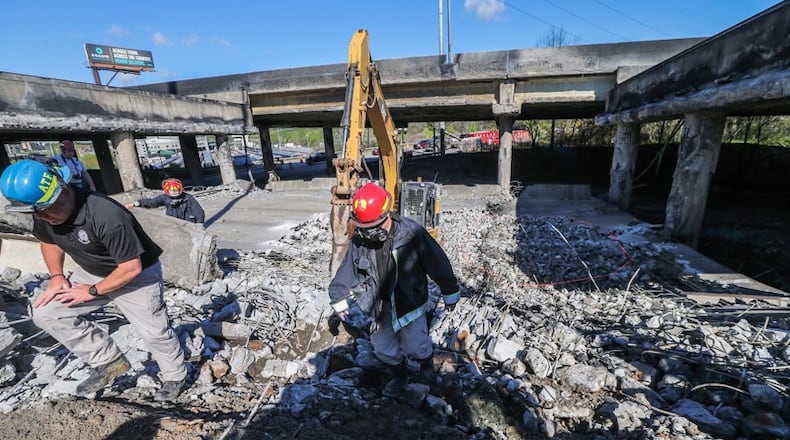2017 was a benchmark year for Atlanta roadways. The year was tumultuous, groundbreaking, and gut-checking. But it was also more of the same, as trip times continued to grow with the economy and driving prowess did not seem to get any better. With that, here are five stories that stood out this year.
The I-85 bridge collapse
The March 30 fire and subsequent collapse of I-85/northbound just south of GA-400 is arguably the single-biggest traffic calamity in Atlanta history. While I-85/northbound collapsed during the fire, the southbound side was damaged enough to prompt its demolition and rebuilding.
But this is where the story gets better. GDOT went straight to work with builder C.W. Matthews on an incentive-laden solution that got the bridge remarkably rebuilt by mid-May. Atlantans were resilient, as we tele-worked, found other routes, took MARTA, and got more patient with the inevitable delays.
And Atlanta also got lucky, as the bridge collapse didn’t damage the nearby MARTA rail yard or HERO headquarters and left the adjacent Buford-Spring Connector nearly unscathed. And GDOT and APD found ways to keep Piedmont Rd. open beneath I-85, to keep that busy road as an open valve for the extra traffic.
The biggest traffic patterns to change were on the Buckhead/Northeast Atlanta side streets and, of course, on I-285. And I-75/85/northbound between the Airport and Midtown, unsurprisingly, was in incredibly low demand. However, as infamous, destructive, and distracting as this calamitous collapse was, the I-85 bridge fire could have been a much worse story.
The Hartsfield-Jackson power outage
As documented here last week, the Dec. 17 massive blackout at the World’s Busiest Airport caused arguably more consequence and economic injury than the I-85 collapse. The lack of communication and emergency deployment displayed incompetence at its highest. Over 1,400 flights got canceled, people sat on the tarmacs for hours, and some sat in the terminals for days, and almost no one knew why the power went out. The backlash and subsequent introspection should bring wholesale changes.
The ramifications from the air traffic affected road traffic surrounding the airport, as people seeking to pick up stranded passengers packed its construction-choked roads.
This outage problem dissolved in a couple of days, making its long term impact on Atlanta transportation and traffic less so than the I-85 bridge, but certainly a huge story
Irma’s impact on traffic
Hurricane Irma’s mid-September striking of first Florida, then Georgia, had a major impact on the Atlanta roads. The chaos started the week before, when the migration from Florida sent jam shockwaves up I-75 in both Henry and Cobb counties and then up into Tennessee. Traffic was nearly unbearable on I-75, but I-285 and I-75/85 saw extra delays as well. Then the reverse happened as the weary travelers began the descent back home.
In the middle, the heavy winds and rain took their toll on Georgia’s roads. Flooding was a big problem in south Georgia on many side roads and the wind took down thousands of trees, wires, and poles in Atlanta. Some people remained without power for nearly a week, meaning some big intersections remained without traffic signals. Crews had to treat downed trees in triage, because of the sheer volume. While the impact in Georgia was nothing like Florida, Irma certainly whacked Atlanta traffic right in the jaw.
The bust that was SunTrust Park traffic
I got this one wrong. The Atlanta Braves’ move to Cobb County was sure to bring extra pain to I-285, especially with the displaced I-85 traffic post-collapse. But supreme engineering by both Braves and the surrounding local governments brought no such gridlock. Yes, traffic increased on I-285, I-75, and the surrounding side roads to the Circle 75 Pkwy.-based stadium, but Cobb County planned enough improvements around the site and deployed enough police to make it flow. The traffic plan really did work, including the idea to move weeknight start times back to 7:35 p.m., just enough past the rush hour peak.
If the Braves and Cobb keep squabbling over who’s to pay for the extra law enforcement, that could affect traffic flow. But for now, the Braves’ move to the Cumberland area has been a traffic success.
I-20 pavement explosion
You probably forgot about this. Just days after the I-85 bridge collapse, crews trying to fill an inactive gas line under I-20 near Flat Shoals Road in DeKalb caused it to explode. The asphalt shot up in a jagged triangle around lunchtime and, at the height of the problem, shut down both sides of I-20. This was a big development, as many motorists were taking I-285 to I-20 or vice-versa, to avoid the I-85 closure.
But by PM drive, the eastbound lanes were already open, as were the right lanes of I-20/westbound. By 6 a.m. the next morning, all of I-20 was open and the pavement replaced. Yet again, Atlanta curbed the impact of a disaster and GDOT did a remarkable job making a quick fix.
About the Author
The Latest
Featured


